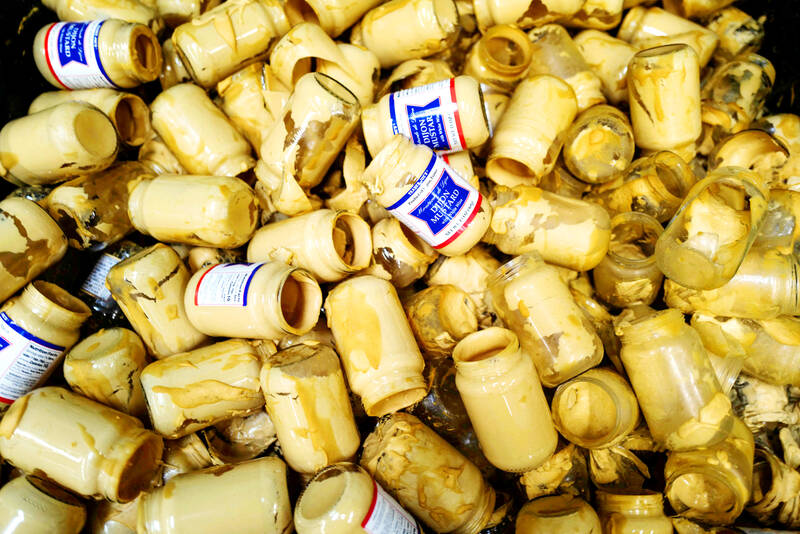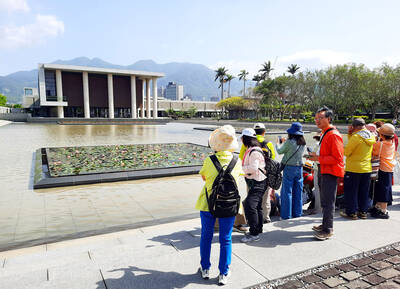France’s favorite condiment, Dijon mustard, is hard to find these days, with signs on supermarket shelves warning the lucky few who spot jars that they can only take one home.
A heatwave across the ocean in Canada, the world’s top mustard seed producer, is to blame for the drastic shortage that has dragged on for months in France.
Canada supplies around 80 percent of the mustard seeds used by French makers of the spicy condiment, the rest coming mostly from Burgundy, the region that surrounds Dijon.

Photo: AFP
But a drought slashed the Canadian harvest by half last year.
Now French mustard makers are aiming to boost production at home in Burgundy.
“It’s very important to increase that share so we can face weather risks that differ from one country to the other,” said Luc Vandermaesen, president of the Burgundy Mustard Association, an industry group.
“We can’t put all our eggs in one basket,” said Vandermaesen, who is also the chief executive of France’s third biggest mustard maker, Reine de Dijon (Queen of Dijon).
DOUBLE THE PRICE
The Dijon region has been famous for its mustard seeds since the Middle Ages, but production has been decimated by pests as chemicals used to kill them have been banned.
Output was divided by three between 2017 and last year, falling from 12,000 tonnes to 4,000 tonnes.
In June, local producers were urged to more than double the area planted with mustard seeds to 10,000 hectares.
“The Canadian problems revived the importance of the Burgundy sector,” said Fabrice Genin, president of the Association of Mustard Seeds Producers of Burgundy.
As an incentive, mustard makers agreed to pay 2,000 euros (US$2,008) per tonne for Burgundy seeds in 2023, up from 1,300 euros last year and more than double what they paid last year. The appeal appears to have worked, with 10,000 hectares planned for mustard seeds, said Jerome Gervais, a mustard expert at the chamber of agriculture in Burgundy’s Cote d’Or department. The number of seed producers jumped from 160 to more than 500, he added. “It’s more than hoped,” Gervais said.
‘REVENGE’
Francois Detain, a farmer in Agencourt, gave up mustard seed production in 2019 after his fields were wrecked by a dry spring and an insect infestation.
But the price offered for mustard seeds allowed him to bring them back, even though Russia’s invasion of Ukraine has made fertilizers more expensive.
A drop in the prices of grains and oilseeds has also made mustard seeds more attractive.
“It’s sort of a revenge for us to be able to replant a local crop,” Detain said.
Shipping costs — which have soared due to supply chain bottlenecks since COVID pandemic lockdowns were lifted — have also given an edge to Burgundy seeds over those from Canada.
By next year, Burgundy should be producing 15,000 tonnes of mustard seeds, meeting 40 percent of the needs of mustard makers, Gervais said.
“(Store) shelves should be replenished in October,” Vandermaesen said. “The shortage will be completely over in early 2023. We are very confident for Christmas.”

When the South Vietnamese capital of Saigon fell to the North Vietnamese forces 50 years ago this week, it prompted a mass exodus of some 2 million people — hundreds of thousands fleeing perilously on small boats across open water to escape the communist regime. Many ultimately settled in Southern California’s Orange County in an area now known as “Little Saigon,” not far from Marine Corps Base Camp Pendleton, where the first refugees were airlifted upon reaching the US. The diaspora now also has significant populations in Virginia, Texas and Washington state, as well as in countries including France and Australia.

On April 17, Chinese Nationalist Party (KMT) Chairman Eric Chu (朱立倫) launched a bold campaign to revive and revitalize the KMT base by calling for an impromptu rally at the Taipei prosecutor’s offices to protest recent arrests of KMT recall campaigners over allegations of forgery and fraud involving signatures of dead voters. The protest had no time to apply for permits and was illegal, but that played into the sense of opposition grievance at alleged weaponization of the judiciary by the Democratic Progressive Party (DPP) to “annihilate” the opposition parties. Blamed for faltering recall campaigns and faced with a KMT chair

Article 2 of the Additional Articles of the Constitution of the Republic of China (中華民國憲法增修條文) stipulates that upon a vote of no confidence in the premier, the president can dissolve the legislature within 10 days. If the legislature is dissolved, a new legislative election must be held within 60 days, and the legislators’ terms will then be reckoned from that election. Two weeks ago Taipei Mayor Chiang Wan-an (蔣萬安) of the Chinese Nationalist Party (KMT) proposed that the legislature hold a vote of no confidence in the premier and dare the president to dissolve the legislature. The legislature is currently controlled

Dull functional structures dominate Taiwan’s cityscapes. But that’s slowly changing, thanks to talented architects and patrons with deep pockets. Since the start of the 21st century, the country has gained several alluring landmark buildings, including the two described below. NUNG CHAN MONASTERY Dharma Drum Mountain (法鼓山, DDM) is one of Taiwan’s most prominent religious organizations. Under the leadership of Buddhist Master Sheng Yen (聖嚴), who died in 2009, it developed into an international Buddhist foundation active in the spiritual, cultural and educational spheres. Since 2005, DDM’s principal base has been its sprawling hillside complex in New Taipei City’s Jinshan District (金山). But